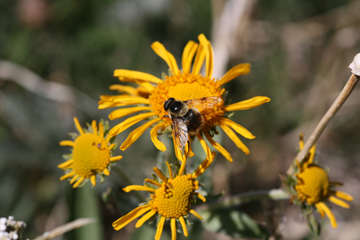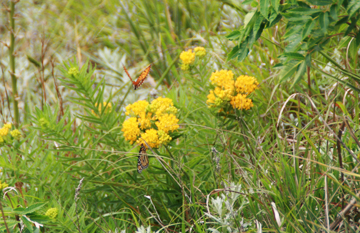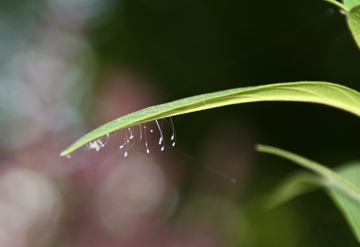Pesticides, Pollinators and IPM
 In honor of National Pollinator Week (June 17-23), a discussion of pollinators, pests, and how we deal with them seems in order. As gardeners, we are aware of the insect life that surrounds our favorite plants and flowers. We anticipate the fruits of our labor a when we plant our first seedlings after frost danger has passed in spring, or sow seed for the following year before winter arrives. One of the most important things to notice about the insects present in our world is that a majority of them are not pests; they are integral parts of the garden ecosystems we create, and the natural landscapes we cherish and steward. Pollination by insects (and animals) is definitely important to increase our favorite blooms, and create seeds for us to restart our favorite plants. However, did you know that approximately two-thirds of the world’s crops rely on bees and other pollinators to pollinate them? [Beyers] Are you aware of the declining populations of pollinators (bees in particular), and the things we can do as homeowners to protect them?
In honor of National Pollinator Week (June 17-23), a discussion of pollinators, pests, and how we deal with them seems in order. As gardeners, we are aware of the insect life that surrounds our favorite plants and flowers. We anticipate the fruits of our labor a when we plant our first seedlings after frost danger has passed in spring, or sow seed for the following year before winter arrives. One of the most important things to notice about the insects present in our world is that a majority of them are not pests; they are integral parts of the garden ecosystems we create, and the natural landscapes we cherish and steward. Pollination by insects (and animals) is definitely important to increase our favorite blooms, and create seeds for us to restart our favorite plants. However, did you know that approximately two-thirds of the world’s crops rely on bees and other pollinators to pollinate them? [Beyers] Are you aware of the declining populations of pollinators (bees in particular), and the things we can do as homeowners to protect them?
Pollinators, such as honeybees and native bees, are disappearing at a rapid rate. A 2007 National Research Council (NRC) study concluded:
“Long-term population trends for the honey bee, the most important managed pollinator, are demonstrably downward…declines starting in 2005 have continued since that study was published, attributable to what is now known as Colony Collapse Disorder (CCD), which is thought to have affected mostly managed bee colonies starting in late 2005. The defining characteristic of CCD is the disappearance of most, if not all, of the adult honey bees in a colony, leaving behind honey and brood, but no dead bee bodies. Scientists at USDA have been looking for the cause/ causes within four broad categories: pathogens, parasites, environmental stressors (pesticides or lack of nectar diversity), and management stressors (transportation stress by migratory beekeepers). Also, long-term population trends for several wild bee species, notably bumble bees, are notably downward.” [Congressional Research Service]
So far, none of the research has been conclusive on the major cause of CCD, and USDA and university researchers have concluded in a 2011 progress report that it is likely a combination of these four factors working together. They are continuing to focus in three major areas: pesticides, parasites/ pathogens, and stresses on immune and social systems of the colonies.” [Congressional Research Service]
 This has a negative effect on food supply in conjunction with the economy. The economic value of honeybee pollination services in the United States is estimated at $14.6 billion annually. For native bees, California has estimated that wild bee species add $2.4 billion per year to California’s agriculture alone. [Congressional Research Service]. So, in addition to food products and ecosystems at stake, there is a monetary aspect attached to this issue.
This has a negative effect on food supply in conjunction with the economy. The economic value of honeybee pollination services in the United States is estimated at $14.6 billion annually. For native bees, California has estimated that wild bee species add $2.4 billion per year to California’s agriculture alone. [Congressional Research Service]. So, in addition to food products and ecosystems at stake, there is a monetary aspect attached to this issue.
So, you are not a beekeeper. Or a California almond farmer. Or a USDA economist. What does all of this mean to you, and how on Earth can you be of help? As a gardener, from window boxes to hundreds of acres, you are involved. Your choice of plants, how you arrange them, and how you treat them are all factors that directly affect pollinators.
First, you can create habitat. Some weeds are not noxious, and are good nectar sources for pollinators. If they are unwanted, try planting native forbs as a source. They can suppress those weeds, and attract beneficial insects as well. Also, mulching new plantings can help keep weeds at bay. These practices can reduce the need for herbicides and insecticides [USDA AF Notes-35]. There are many plants in addition to natives that are wonderful nectar sources for bees and beneficial insects, as well. Also, how you plant them can affect the ability of foraging insects; for example, planting species in clumps allows for more efficient foraging.
There are many great sources to help you choose your plants, and create a functional and beautiful habitat for pollinators:
- US Fish and Wildlife Service - http://www.fws.gov/pollinators/Index.html
- North American Pollinator Protection Campaign - http://www.pollinator.org/guides.htm
- The Xerces Society - http://www.xerces.org/pollinator-conservation/
- Natural Resources Conservation Service [NRCS] - http://efotg.sc.egov.usda.gov/references/public/il/btechnote23.pdf
- Great Pollinator Project - http://greatpollinatorproject.org/management/habitat-restoration
- Ecological Society of America - http://www.esa.org/ecoservices/PollinationWhatYouCanDo.pdf
- Colorado State University Extension (there are many other links) - http://www.ext.colostate.edu/pubs/columngw/gr130420.html
 Another important aspect of conserving healthy habitats is practicing Integrated Pest Management, or IPM, when problems do arise. IPM is the practice of resolving pest issues through mechanical, cultural, sanitary, biological and chemical practices. For example, let’s say you have an infestation of aphids on lettuce, Lactuca sativa. Here is what each of the control measures could consist of:
Another important aspect of conserving healthy habitats is practicing Integrated Pest Management, or IPM, when problems do arise. IPM is the practice of resolving pest issues through mechanical, cultural, sanitary, biological and chemical practices. For example, let’s say you have an infestation of aphids on lettuce, Lactuca sativa. Here is what each of the control measures could consist of:
- Mechanical: removing the aphids by spraying them with high powered water
- Cultural: choosing a cultivar that is resistant to aphids
- Sanitary: removing the infested plant to protect the less infested/ keeping the area free of weeds that aphids may persist on
- Biological: releasing beneficial insects, such as predatory and parasitoid wasps Aphidius and Aphidoletes, or green lacewings Chrysoperla spp.
- Chemical: Choosing a pesticide that is relevant for aphids
When practicing IPM, using chemicals is always the last resort. Many times, the high powered water is completely sufficient! If you do have to apply a chemical, one of the most important things you can do to protect pollinators is to become educated on pesticides. Many of the chemicals available to homeowners are currently not required to warn of bee toxicity that may occur over time, or other adverse effects of the product. They have simple names like ‘Bayer Tree and Shrub Protect,’ which gives the user no indication of what that chemical actually does, to what insect, and what other effects it might have on the natural environment. Taking the time to learn about the chemical, its formulation, how to apply the appropriate amount and apply it correctly are worth it for pollinators, as well as your family and public health. Also, learn your pest! Broad spectrum insecticides are usually just that; they can be harmful to the good guys as well as the bad.
You can always take samples to your local extension office if you cannot figure out what insect you have. Another misconception is that if a product is labeled ‘organic’, that it is less harmful to bees and public safety, which is not always true. Whether a substance comes from natural or artificial sources, if it controls pests, it is a pesticide. [http://citybugs.tamu.edu/factsheets/ipm/ent-4002/] So, even if it is OMRI (Organic Materials Review Institute) listed, it is still important to understand its effects. Luckily, there are many online sources of information to help you decipher what chemicals you feel comfortable using, as well as about IPM:
- National Pesticide Information Center - http://npic.orst.edu
- Beyond Pesticides - www.beyondpesticides.org
- University of California IPM Online - http://www.ipm.ucdavis.edu/index.html
- Safer Pest Control Project - www.spcpweb.org/yards
- Pesticide Action Network North America - http://www.panna.org
- Safelawns.org - www.safelawns.org
- City of Boulder, Colorado: Healthy Parks=Healthy People Campaign - http://www.bouldercolorado.gov/files/BoulderHealthyParks.pdf
- Pesticide Environmental Stewardship - http://pesticidestewardship.org
- Center for Food Safety - www.centerforfoodsafety.org
- US Department of Health and Human Services Household Products Database - http://householdproducts.nlm.nih.gov
- Denver Botanic Gardens: Horticulture Staff - www.botanicgardens.org
So, next time you bite into a juicy apple, or when you excitedly harvest your first summer squash this season, think about the pollinators. Think about all they do for us, and then contemplate the simple things we can do to give them a little back.
Sources
- Beyers, Becky, Killer in a Bottle? Household insecticides may play a role in declining bee populations, University of Minnesota CFANS - http://www.cfans.umn.edu/Solutions/Fall2012/Killer_Bottle/index.htm
- Schierow, Linda-Jo, Renee Johnson and M. Lynne Corn, Bee Health: The Role of Pesticides, December 11, 2012, Congressional Research Service: 7-5700, R42855 - www.crs.gov
- AF Note-35: Pesticide Considerations for Native Bees in Agroforestry. M. Vaughn and S. Black. 2007. USDA National Agroforestry Center. http://nac.unl.edu/documents/agroforestrynotes/an35g09.pdf
- Sanford, Malcolm T., Protecting Honey Bees from Pesticides, May 2003, University of Florida IFAS Extension CIR534 - http://edis.ifas.ufl.edu/pdffiles/AA/AA14500.pdf
- Merchant, Michael, Insects in the City: Understanding Common House and Garden Insecticides, Texas A and M AgriLife Extension - http://citybugs.tamu.edu/factsheets/ipm/ent-4002/
Add new comment